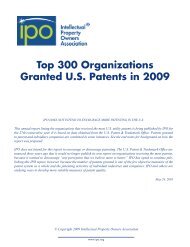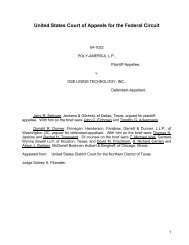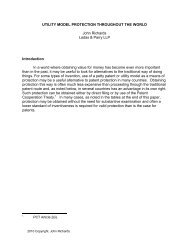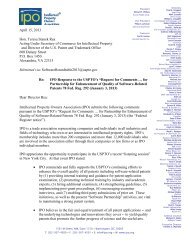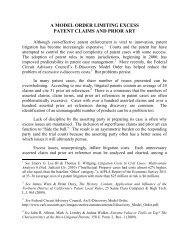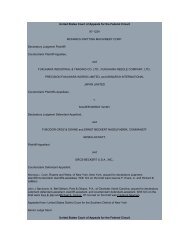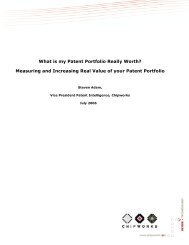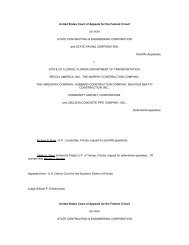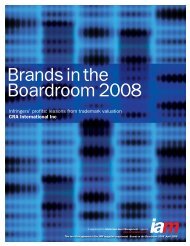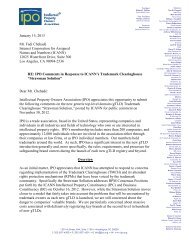Ruiz v. A.B. Chance Co.
Ruiz v. A.B. Chance Co.
Ruiz v. A.B. Chance Co.
You also want an ePaper? Increase the reach of your titles
YUMPU automatically turns print PDFs into web optimized ePapers that Google loves.
In April 1989, <strong>Ruiz</strong> incorporated Fasteel to provide building stabilization services using <strong>Chance</strong>’s products<br />
and methods. <strong>Ruiz</strong> is Hispanic, and is the sole owner of Fasteel. In June 1989, <strong>Chance</strong> and <strong>Ruiz</strong> entered<br />
into a "Distributorship Agreement," whereby <strong>Chance</strong> appointed Fasteel to act as an authorized, nonexclusive<br />
distributor. The Agreement contained a "best efforts" clause. For the next few years, <strong>Ruiz</strong> and<br />
Fasteel sold <strong>Chance</strong> products exclusively and only used the <strong>Chance</strong> underpinning method. <strong>Ruiz</strong> and Fasteel<br />
also recruited dealers for the <strong>Chance</strong> method, created marketing materials, developed products, and<br />
conducted training programs. <strong>Ruiz</strong> extolled the advantages of the <strong>Chance</strong> methods over the prior art to other<br />
contractors.<br />
In the 1990s, <strong>Ruiz</strong> expanded his business by forming other companies. In 1993, <strong>Ruiz</strong> incorporated<br />
Foundation Technology, Inc. ("FTI"), originally the Kansas City, Missouri, office of Fasteel. <strong>Ruiz</strong> was the sole<br />
owner of FTI. At first, FTI only sold <strong>Chance</strong> products, but by 1997, it was also the distributor for foundation<br />
repair parts not manufactured by <strong>Chance</strong>. In 1995, <strong>Ruiz</strong> and Steven Gregory established R.J. Enterprises,<br />
L.L.C., to sell Ram Jack products, which were competitive with <strong>Chance</strong>’s products. The Ram Jack products<br />
utilized the Gregory patented push pier method. <strong>Ruiz</strong> had a 51 percent interest in R.J. Enterprises. <strong>Ruiz</strong> also<br />
set up Advanced Building Technology, Inc. ("ABT"), wholly-owned by <strong>Ruiz</strong>, to sell Ram Jack products.<br />
According to <strong>Ruiz</strong>, FTI or ABT would distribute Ram Jack products in locations where <strong>Ruiz</strong> was already a<br />
<strong>Chance</strong> distributor. R.J. Enterprises would service those areas where <strong>Ruiz</strong> did not distribute <strong>Chance</strong><br />
products.<br />
In 1996, <strong>Chance</strong> became aware that <strong>Ruiz</strong>, through one of his companies, had offered Ram Jack products to<br />
a dealer in <strong>Chance</strong> territory for which <strong>Ruiz</strong> was responsible. <strong>Chance</strong> requested that <strong>Ruiz</strong> stop the activity.<br />
<strong>Ruiz</strong> wrote <strong>Chance</strong> a letter arguing that <strong>Chance</strong> had allowed other distributors to sell competitive products,<br />
and that he believed <strong>Chance</strong>’s actions to be motivated by a discriminatory purpose.<br />
On February 18, 1997, Gary Bartee, a <strong>Chance</strong> manager, and Mike Estes, <strong>Chance</strong>’s controller, signed a<br />
"Distributor Termination Request" form. The form stated that <strong>Chance</strong> was terminating Fasteel because<br />
"Fasteel, Inc., is establishing itself to promote and sell competitive underpinning system[s] through the<br />
existing <strong>Chance</strong> system dealers." The next day, Jeff Witten, the Senior Vice-President of <strong>Chance</strong>’s parent<br />
company, terminated Fasteel’s distributorship pursuant to a provision in the Distributorship Agreement,<br />
which permitted termination "for any reason" upon one year’s notice.<br />
After the termination, <strong>Ruiz</strong> began to market and install a combination of screw anchors manufactured by<br />
Dixie and metal brackets manufactured by Gregory. <strong>Chance</strong> alleged that <strong>Ruiz</strong>’s activities infringed its<br />
method patents, and ordered <strong>Ruiz</strong> to cease his activities. <strong>Ruiz</strong> refused.<br />
D. The District <strong>Co</strong>urt Proceedings<br />
On August 11, 1997, <strong>Ruiz</strong> and Fasteel filed suit in the United States District <strong>Co</strong>urt for the Eastern District of<br />
Missouri, alleging that <strong>Chance</strong>’s termination of the Distributorship Agreement constituted discrimination<br />
under section 1981, breach of contract, breach of the implied duty of good faith and fair dealing, promissory<br />
and equitable estoppel, and tortious interference with contract and prospective business relations. <strong>Ruiz</strong> and<br />
Fasteel also sought a declaration of noninfringement and invalidity of <strong>Chance</strong>’s two method patents (the<br />
’368 and ’107 patents) and <strong>Chance</strong>’s apparatus patent, U.S. Patent No. 5,120,163 ("the ’163 patent").<br />
<strong>Chance</strong> filed a counterclaim alleging infringement of the ’368, ’107, and ’163 patents. In a well-reasoned and<br />
thorough opinion, on April 20, 1999, Judge Catherine Perry granted summary judgment against <strong>Ruiz</strong> and<br />
Fasteel on the non-patent claims.<br />
After holding a Markman hearing and issuing an order construing the claims at issue, the district court held a<br />
bench trial on invalidity and infringement of the <strong>Chance</strong> patents. During trial, <strong>Chance</strong> dismissed its claim that<br />
<strong>Ruiz</strong> and Fasteel had infringed the ’163 patent, and the parties narrowed the infringement issue to whether<br />
<strong>Ruiz</strong> and Fasteel had infringed claims 1 through 4 and claims 6 through 8 of the ’368 and ’107 patents. On<br />
May 25, 1999, the district court, in an opinion stated from the bench, found that <strong>Ruiz</strong> and Fasteel had<br />
infringed claims 1 through 4 and claims 6 through 8 of the <strong>Chance</strong> patents, and that <strong>Chance</strong> had proved with<br />
sufficient certainty $540,000 in damages. The district court, however, entered judgment for <strong>Ruiz</strong> and<br />
Fasteel, because they had showed clear and convincing evidence that claims 1 through 4 and claims 7 and<br />
8 were invalid for obviousness in light of the teachings of the use of push piers and metal brackets as taught<br />
by the Gregory patents in combination with the use of screw anchors and concrete haunches as used by<br />
Fuller and Rupiper. On August 5, 1999, the district court amended its judgment, and found that <strong>Ruiz</strong> and



